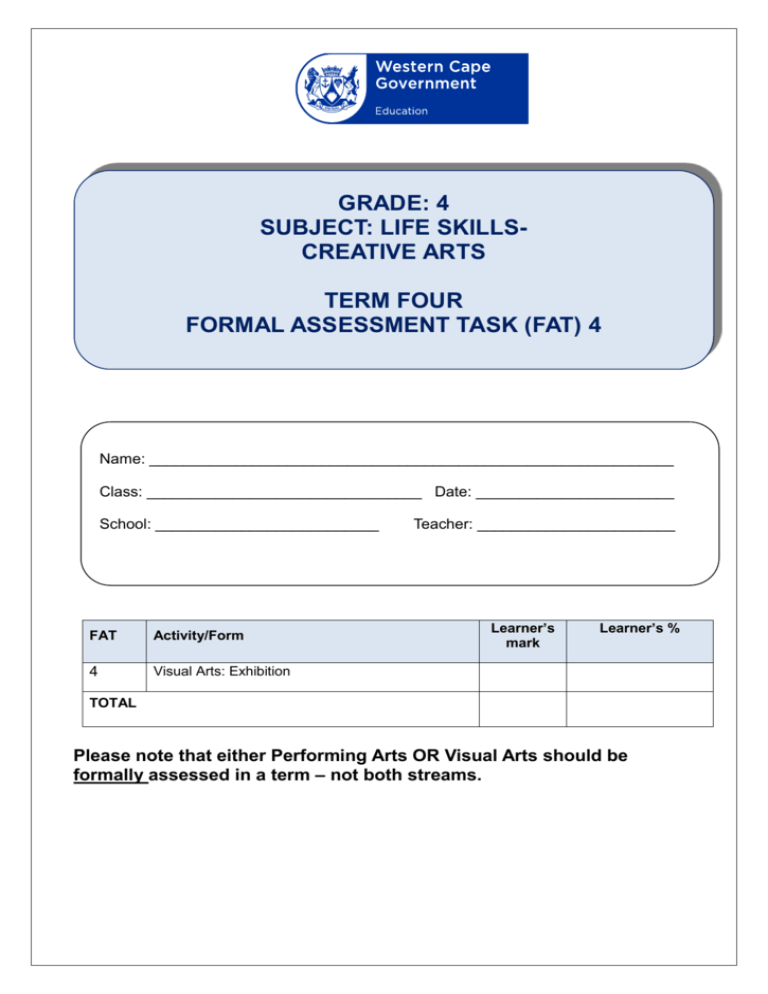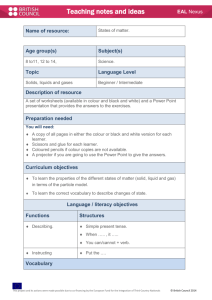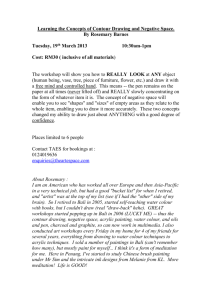Visual arts FAT Grade 4 (Eng)
advertisement

GRADE: 4 SUBJECT: LIFE SKILLSCREATIVE ARTS TERM FOUR FORMAL ASSESSMENT TASK (FAT) 4 Name: _____________________________________________________________ Class: ________________________________ Date: _______________________ School: __________________________ FAT Activity/Form 4 Visual Arts: Exhibition Teacher: _______________________ Learner’s mark Learner’s % TOTAL Please note that either Performing Arts OR Visual Arts should be formally assessed in a term – not both streams. LIFE SKILLS: CREATIVE ARTS FORMAL ASSESSMENT TASK: VISUAL ARTS GRADE 4 TERM 4 NOTE TO THE TEACHER: The Formal Assessment Task has been developed as a step by step guideline to learners. The activities are to be done in class, during the fourth term. It is important that teachers mediate the various steps of the task with learners to ensure active, creative and critical participation by all learners. ACTIVITY 1: CREATE IN 2D, IMAGES OF THE NATURAL WORLD ART MATERIALS: Any of the following: A4 & A3 paper HB pencils 2B / 3B pencils Charcoal Oil pastels Coloured inks and powder paints INSTRUCTIONS: You will be drawing an animal in its natural environment. In this artwork, you will use the elements of art called LINE, SHAPE and SECONDARY and RELATED COLOUR and the design principles called CONTRAST and PROPORTION. It is very important to look really closely at pictures / photographs of animals in their natural world (OBSERVATION). You must concentrate hard and look at all the unique aspects of the animal form. CREATIVE ARTS GRADE 4 TERM 4: FORMAL ASSESSMENT TASK: VISUAL ART 1 | PAGE INSTRUCTIONS: Discuss: With the help of your teacher explore what you already know of the concepts of drawing and of the form of the animal. Look at all the different types of animals. Look at the different shapes and forms. How is the animal shaped? Does it have a long body or a short body? Are the legs long or short, etc.? What does its coat/fur/skin look like? Does it have specific colouring? Your teacher will guide you when selecting the media with which you will be working. Let us first set the scene: Your teacher will show you different pictures of animals in various types of environments for you to observe more closely. Notice the different colours and interesting patterns of the animals’ fur/coat/skin, as well as the different facial features and the way the body is shaped. CREATIVE ARTS GRADE 4 TERM 4: FORMAL ASSESSMENT TASK: VISUAL ART 2 | PAGE You need to observe and draw from what you see rather than what you know. Discuss the animals in detail with each other and your teacher. Look carefully at the animal’s proportions, the way the legs move, different patterns and colours, etc. Select an animal that you wish to draw – try to choose one that will challenge and excite you. Let us practise first: First trace the lines of the animal’s form in the air. Now, take an HB pencil and on an A4 piece of paper, begin to draw the animal. Try not to take your eyes off the animal’s form as you should draw exactly what you see. There is no right or wrong! Take your time and draw your lines slowly and carefully. Now let us start the final artwork: Your teacher will now hand out a bigger sheet of paper (A3). You will now draw the animal you selected again using the 2B & 3B pencils. Just draw the animal! Your lines should be solid and reflect the position or view of the animal. Make sure that you position the animal correctly on the page. Be careful not to draw your picture just in a corner of the page. Your drawing must be clearly visible and should take up at least half of your page. Draw the animal carefully using lines that are similar to what you see. Try not to take your eyes off it for too long. Once you have completed the animal select a background that depicts the natural world (environment) of the animal. Draw the environment in the open spaces of the page, or in the background of the picture. CREATIVE ARTS GRADE 4 TERM 4: FORMAL ASSESSMENT TASK: VISUAL ART 3 | PAGE Let’s add colour: Your picture is made up of different types of lines at this stage; you may have thick, thin, smooth, jagged, little short lines or long smooth lines. Once the drawings are completed your teacher will discuss the use of colour in your artwork, especially related colours. Add colour to your picture using the oil pastels, crayons or colour pencils. Firstly, use the colours that you feel would suit your picture best. Look again at your picture and add your final touches to ensure that you are satisfied with the use of colour and line. When you have completed your art work, your teacher will ask you to write your name in the bottom corner of the picture. Your teacher will mount your picture and display it on the wall. Your artwork will be assessed by your teacher who will look at the following aspects of it. CRITERIA 1-3 4-5 Different types of line have been used to depict the animal form. Composition: The page is used fully and the drawing is well situated The art medium has been well applied. The learner can use it in an appropriate manner. Attempted to use different types of line, but not able at all. Less than a quarter of the page is covered by the composition Able to, but not consistent. Needs more practice. Approximately half of the page is covered by the composition Able to apply colour, but not consistent. Needs more practice. Able to express him/herself in a meaningful manner. Needs more practice. The learner has expressed him/herself confidently. Inappropriate application of the art medium. Attempted to express him/herself, but not able attain the desired outcome. 6-7 8-10 Has met the criteria and can move on to the next level. Bold use of different types of line to depict the animal. Three quarters of the page is covered by the composition More than 80 % of the page is covered by the composition Has met the criteria to apply colour appropriately. The colour has been applied correctly and enhances the picture. Has met the criteria to express him/herself confidently and in a meaningful manner. Exceeds expectations and criteria to express him/herself confidently. Subtotals: TOTAL /40 Considering inclusivity: Learners with visual impairment: you could do the same activity using touch to determine the shape and form of the object. Textured material like crayons should be used when drawing. For learners who experience cognitive barriers, break the activity down in smaller, more manageable steps. Ensure that all learners have an opportunity to complete all the steps at their own pace. CREATIVE ARTS GRADE 4 TERM 4: FORMAL ASSESSMENT TASK: VISUAL ART 4 | PAGE INTEGRATED LEARNING AND ASSESSMENT STRATEGY The learning and assessment processes are integrated. Assessment is continuous and formative as the teacher will observe the progress of the learner towards the final art work. The final art work is assessed formally by the teacher by means of a rubric. Activity: Assessment Assessment Assessment Assessment CREATE IN 2D, Form Method Technique Instrument Informal: Self/peer/teacher Process towards Class list (just to Formative assessment final art work be ticked off) Formal: Teacher Final art work Rubric IMAGES OF THE NATURAL WORLD Summative DISTRIBUTION OF COGNITIVE LEVELS REMEMBER AND APPLY AND ANALYSE EVALUATE AND CREATE Visual Arts elements and Application of elements and Creating and presenting of principles: line, shape and principles in 2D art work. the 2D art work. secondary and related colour Continuous critical reflection and contrast and proportion. and application to improve the UNDERSTAND art work during class time. (According to the Adapted Blooms’ Taxonomy, 1990) CREATIVE ARTS GRADE 4 TERM 4: FORMAL ASSESSMENT TASK: VISUAL ART 5 | PAGE







